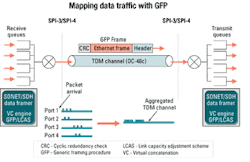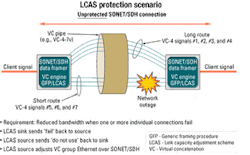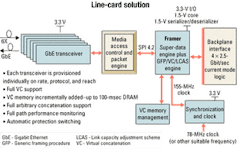Multiprotocol, multichannel, multirate framers for SONET/SDH
Framer Technology
The days of "build it and they will come" have abruptly ceased in the communications world. Service providers and the equipment vendors that supply them are struggling to manage the rate of change in communications networks. Semiconductor technology must adapt to the new economics of data and voice communications networks.
In fact, most public and private communications networks are facing a fundamental shift away from voice traffic toward a preponderance of data traffic, including Ethernet and IP on their transport links. This shift is putting increasing pressure on the traditional circuit-based SONET/
SDH transport networks. These time-proven and widely installed networks for voice need to become more efficient for non-voice traffic. That is not a small challenge, since SONET/SDH was designed to support TDM traffic and not the less predictable traffic flows typical of data communications. However, the wealth of investment in equipment, software, knowledge, and network management experience underscores the need to find a means not only to leverage the existing network but also to extract increased operational efficiencies from that network.
For the service provider and ultimately for the OEM equipment vendor, these facts of life lead to some general technical and business challenges:
- How to enable the maximum use of the installed infrastructure. Carriers and equipment manufacturers must drive more revenues from existing network services by using them more efficiently, without the need for a complete network "forklift" upgrade and increased capital expenditures.
- How to enable service providers to generate additional revenue streams through new and differentiated services. As new access technologies come to market, the ability to interface them with the existing network infrastructure at minimum expense, rework, and disruption to services becomes very important. New services such as Ethernet-in-the-local-loop or metropolitan Ethernet, will enable service providers to provide communications services that better match the needs and cost points of their customers.
- The price points of how services are built, upgraded, and maintained will need to change to reflect the new economic realities. Customers need flexibility and scalability to preserve their infrastructure investments, while at the same time maintaining performance and service levels that can grow with future expectations. That means technologies that require only incremental capital investment for each service activation and thus improve return on investment.
- The challenges facing the service provider drive challenges to the equipment designer and ultimately component vendors. Next-generation gear will need to have a smaller footprint and provide higher channel densities while costing less and using less power. To achieve these goals, OEMs will require strategies that enable them to do hardware (board) and software development once, reusing intellectual property, proven code, and modular, expandable hardware elements like multichannel, multirate framers and pluggable optics wherever possible. The goal is to cut development time and the costs associated with development, deployment, and operation.
These challenges are particularly striking today as the SONET/SDH world is transitioning to support 10-Gbit/sec data communications. Ethernet plays a key role here, because it is understood and supported by virtually all enterprises. The controversy over how to send Ethernet traffic in MANs is quickly settling on SONET/SDH as the answer. The issue now is how to support 10 Gbits/sec and make SONET/SDH better and cheaper without requiring a forklift-level upgrade while maintaining support for legacy networks. To this end, data over SONET/SDH technologies such as Ethernet over SONET/SDH (EoS) and Gigabit Ethernet over SONET/SDH (GEoS) are shaping up as the key enablers.
One of the key components for SONET/SDH network interfaces is the SONET/SDH framer. Framing is the technology that designates or marks channels within a bit stream, providing the basic timeslot structure and management, fault isolation, and sectionalization transport protocol of choice for telecommunications.
SONET/SDH framing is accomplished by creating an underlying pattern using a regularly spaced marker to provide byte-level synchronization and divide the bit stream (which is always transmitting) into separate payload channels and overhead channels (which enables status information to be sent without affecting payload). SONET/SDH framing is based on the STS-1 bit stream, which transmits at 51.84 Mbits/sec or 810 bytes every 125 msec.
New framer ICs bring two important innovations to the SONET/SDH market that distinguish them from their predecessors: support for virtual concatenation (VC) and support for generic framing procedure (GFP). They combine with other capabilities within the framers themselves as well as with capabilities in companion chips to enable single devices and ultimately single OEM designs to support multirate, multiprotocol, and multichannel solutions over SONET/ SDH—key capabilities for service providers that need to provide their customers with a wide range of networking options.
Concatenation is a method used to bind a number of individual signals together to create a super-rate logical channel that provides more bandwidth than is available in one of the constituent signals. Contiguous concatenation, an existing but rarely used technology, requires that all intermediate network nodes support contiguous concatenation functions. Many installed network elements (NEs) in SONET/SDH networks cannot support contiguous concatenation and would be prohibitively costly to upgrade or replace.
Virtual concatenation provides the NEs at both ends of a signal path the ability to send/receive arbitrary individual STS-1 virtual circuits (or VC-4 for SDH networks, which refers to SDH virtual container-level four) in a concatenated group. So rather than have to upgrade all the NEs, VC confines upgrade costs to the ends of the path. Virtually concatenated links are therefore intelligible only between the source and sink network nodes (and independent of the NEs in between).
VC is one of the big reasons that EoS has become a force in the metro-networking sector. Developed by the International Telecommunication Union (ITU), the VC spec allows carriers to provision OC-48 (SONET) or STM-16 (SDH) pipes on an STS-1 (51.84-Mbit/sec) or STS-3/VC-4 (155-Mbit/sec) basis. Therefore, designers can band together the appropriate number of STS-1s or VC-4s to support a Gigabit Ethernet (GbE) stream while provisioning a different set of STS-1s/VC-4s to handle a Fast Ethernet stream. Hence, VC enables the equipment and ultimately the service provider to provide multiple right-sized channels for an increasing number of data applications over SONET.
For example, transporting GEoS using older technology would result in a 42% bandwidth efficiency when using an STS-48c (2.5-Gbit/sec) contiguously concatenated channel. With the older concatenation approach, the network provider could slice up his capacity in an OC-48 link into units of STS-1 (51.84 Mbits/sec), STS-3/STM-1 (155 Mbits/sec), or STS-12/STM-4 (622 Mbits/sec). However, it was not possible to mix and match the various pipes, because there would be no guarantee that the same pipes would be available at both ends of the network.
The new approach solves this problem using VC techniques that support different-sized pipes. With VC, the GEoS network provider can achieve 95% utilization of the transport channel for data applications (STS-1-21v for each GbE stream for SONET or VC-4-7v for SDH), and the remaining STS-1/VC-4 channels may still be used for voice applications. In some multiprotocol applications, VC may reduce wasted capacity by as much as 75%.
In addition, VC enables a new service level, opening the possibility for enhanced revenues. With VC, it is possible to assign "protection bandwidth" to a signal in a virtually concatenated group that requires some level of capacity insurance. That means a service provider can reserve some level of bandwidth availability for a particular application and charge a premium for such service.
The GFP is also a key ingredient in the adoption of EoS technology. Defined under the ITU G.7041 specification, GFP is a protocol-agnostic frame delineation and encapsulation mechanism for transporting arbitrary datagrams or packets (e.g., Ethernet packets).
GFP is a framing procedure for octet-aligned, variable-length payloads for mapping into SONET/SDH synchronous payload envelopes. GFP frames are mapped into SONET/SDH frames row-wise, similar to the mapping for ATM or point-to-point protocol (PPP). The value of GFP is that it provides encapsulation for higher-layer protocols such as Ethernet and PPP. GFP comes in two flavors: frame-mapped and transparent. In the case of GbE and IP, the frame-mapped method is the preferred option.
GFP allows flexible and efficient adaptation of multiple protocols for transmission over SONET/SDH networks (see Figure 1). GFP has extremely low overhead requirements and robust frame delineation qualities. As a result, GFP makes it easier for service providers to perform switching tasks, avoiding overhead-intensive flag-based adaptation schemes, such as packet over SONET/SDH, used for IP router interconnection over WANs. That simplifies component complexity and lowers chip count and required real estate while reducing equipment size and manufacturing costs.Figure 1. Data-packet traffic is aggregated onto a TDM channel using generic framing procedure (GFP) for pure virtual-private-network services. Packets in queues are ordered and directed onto a TDM channel, then delivered and unassembled on the receive side. While this example shows an OC-48 pipe, combining GFP with virtual concatenation and the link capacity adjustment scheme enables scalable operation of data services at Layer 1 in a network.
With an increasing number of transport protocols being used over SONET/SDH, such as PPP and high-level data link control, service providers need an efficient method to support multiple protocols with simplified hardware and software designs. By providing such a method, equipment and network efficiency can be enhanced and ultimately costs can be reduced.
While GFP and VC are pretty much standard options, the link capacity adjustment scheme (LCAS) and the link-access procedure for SDH are currently optional additions for manufacturers. LCAS can be viewed as a supplement to VC, allowing designers to adjust the capacity of the VC group in real time. Therefore, carriers and equipment manufacturers can adjust the amount of STS-1s/VC-4s provided in a group to meet the changing needs of end users and adjust to changing conditions in a network. Most data services do not require the full bandwidth all the time. LCAS allows the number of STS-1/VC-4 containers to be adjusted dynamically within the network.
For service providers, the big payoff with LCAS is being able to oversubscribe the network by a factor of two to four while maintaining profitability through service-level-agreement (SLA) delivery (see Figure 2). VC on its own cannot deliver this key performance metric, because both ends of the resized pipe need to synchronize on when to switch. Although this synchronization can be achieved in software over several seconds or minutes, service providers face another challenge when crossing over operational-support-system domains, since the software systems in place today do not support this seamless handoff, making real time synchronization difficult.Figure 2. Virtual concatenation is set up at each end, establishing protection in an otherwise unprotected network of capacity. In this example, an STS-1 pipe carrying seven channels can guarantee reliability through the link capacity adjustment scheme (LCAS), establishing multiple routes to scale around any network outages. LCAS enables user-defined scenarios to adjust the bandwidth down during a signal failure (sending only signals 1-4) or request additional bandwidth (to send all seven signals across route A).
On the other hand, LCAS's nonstandardized structure adds a level of design complexity and risk to any OEM trying to decide how and when to build-in support. Ultimately, framer silicon that supports LCAS offers a lower-cost and lower-risk solution to the problem.
Advances in semiconductor technology are giving chip designers higher processing performance while freeing real estate to add functionality. For example, GFP, VC, and LCAS are now supported in next-generation SONET/SDH framer ICs that also include a wealth of valuable traffic management capabilities. The expanded capabilities and modularity of these new ICs is changing the OEM design constraints and promises service providers new levels of flexibility.Figure 3. This full multirate, multiprotocol, multichannel line card illustrates the advantages of the new generation of SONET/SDH framers.
Other SONET/SDH framer ICs available today address squarely the multiprotocol, multirate issues with GEoS (see Figure 3). These devices combine GbE support with add/drop-multiplexer, VC, and other functions on a single die, again reducing an OEM's time-to-market while improving a system's cost, power, and size.
Traditional Ethernet is a simpler, less expensive solution for moving data traffic over available bandwidth; however, it is only optimized for point-to-point or mesh topologies and not the ring topologies of SONET/SDH networks. Thus, Ethernet cannot take advantage of inherent ring-topology functions to implement protection mechanisms. New GEoS solutions, however, can transport GbE frames over existing SONET/SDH rings by taking advantage of VC to map and un-map arbitrary groups of STS-1/VC-4 signals. These devices build higher-capacity payloads whereby a stream of data is divided among a set of STS-1/VC-4 carriers as it is transmitted, then realigned and multiplexed as it is received. This capability enables OEM NEs to connect with and utilize SONET/SDH networks more quickly and easily, reducing overall system power and cost for both EoS and packet over SONET/ SDH applications.
The SONET/SDH infrastructure is likely to remain the dominant transport medium in optical networks for some time to come. The useful life of SONET/SDH will be extended as they evolve to become more efficient and flexible in supporting new transport services. OEMs designing for the SONET/SDH market are well advised to look for component suppliers that can offer:
- Semiconductor products that meet stringent SONET/SDH timing and jitter requirements. In the high-speed synchronous networking world, timing is crucial, much more so than in traditional data communications applications. Designing and building as well as verifying functional elements like STS-1/VC-4 processors embedded within a framer IC that meets SONET/SDH timing requirements are tasks that demand experience in both silicon design and SONET/SDH implementation.
- High-functionality ICs. To remain competitive, OEMs need to work with silicon that is at the cutting edge of functionality and performance. IC suppliers in turn need to be on top of advances in silicon design and manufacturing technologies as well as communications standards and evolving market requirements. Advances in silicon technology enable IC engineers to pack more features and functions on-chip, while reducing parts cost and power requirements. Knowing what features and functions to include involves a deeper understanding of the market requirements and the customers' design goals.
Chris Hamilton is director of segment marketing and Nathaniel Grier is marketing director, optical-networking ICs, at Agere Systems (Allentown, PA).



